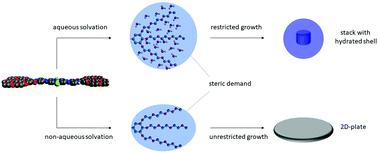当前位置:
X-MOL 学术
›
Soft Matter
›
论文详情
Our official English website, www.x-mol.net, welcomes your
feedback! (Note: you will need to create a separate account there.)
Morphology control in metallosupramolecular assemblies through solvent-induced steric demand.
Soft Matter ( IF 2.9 ) Pub Date : 2020-07-07 , DOI: 10.1039/d0sm00537a Nils Bäumer 1 , Kalathil K Kartha , Jasnamol P Palakkal , Gustavo Fernández
Soft Matter ( IF 2.9 ) Pub Date : 2020-07-07 , DOI: 10.1039/d0sm00537a Nils Bäumer 1 , Kalathil K Kartha , Jasnamol P Palakkal , Gustavo Fernández
Affiliation

|
Controlling the supramolecular self-assembly of π-conjugated systems into defined morphologies is a prerequisite for the preparation of functional materials. In recent years, the development of sophisticated sample preparation protocols and modulation of various experimental conditions (solvent, concentration, temperature, etc.) have enabled precise control over aggregation pathways of different types of monomer units. A common method to achieve pathway control consists in the combination of two miscible solvents in defined proportions – a “poor” and “good” solvent. However, the role of solvents of opposed polarity in the self-assembly of a given building block still remains an open question. Herein, we unravel the effect of aggregation-inducing solvent systems of opposed polarity (aqueous vs. non-polar media) on the supramolecular assembly of a new bolaamphiphilic Pt(II) complex. A number of experimental methods show a comparable molecular packing in both media driven by a synergy of solvophobic, aromatic and weak hydrogen-bonding interactions. However, morphological analysis of the respective aggregates in aqueous and non-polar media reveals a restricted aggregate growth in aqueous media into spherical nanoparticles and a non-restricted 2D-nanosheet formation in non-polar media. These findings are attributed to a considerably more efficient solvation and, in turn, increased steric demand of the hydrophilic chains in aqueous media than in nonpolar media, which can be explained by the entrapment of water molecules in the hydrophilic aggregate shell via hydrogen bonds. Our findings reveal that the different solvation of peripheral solubilizing groups in solvents of opposed polarity is an efficient method for morphology control in self-assembly.
中文翻译:

通过溶剂诱导的空间需求控制金属超分子组装体的形态。
将π共轭体系的超分子自组装控制为确定的形态是制备功能材料的先决条件。近年来,复杂的样品制备方案的发展以及各种实验条件(溶剂,浓度,温度等)的调节,使得能够精确控制不同类型单体单元的聚集途径。实现途径控制的常用方法是将两种可混溶的溶剂按规定的比例混合-“差”和“良”溶剂。但是,极性相反的溶剂在给定构件的自组装中的作用仍然是一个悬而未决的问题。在本文中,我们揭示了极性相反的聚集诱导溶剂系统(水与水)的影响。非极性介质)在新的双亲性Pt(II)络合物的超分子组装上。许多实验方法表明,在疏溶剂,芳族和弱氢键相互作用的协同作用下,两种介质都具有可比的分子堆积。但是,对水性和非极性介质中各自聚集体的形态学分析显示,水性介质中聚集体向球形纳米颗粒的生长受到限制,而非极性介质中2D纳米片的形成不受限制。这些发现归因于与非极性介质相比,溶剂在水性介质中的溶剂化效率更高,并且亲水链的空间需求增加,这可以通过将水分子截留在亲水性聚集壳中来解释。氢键。我们的发现表明,相反极性溶剂中外围增溶基团的不同溶剂化是自组装中形态控制的有效方法。
更新日期:2020-07-29
中文翻译:

通过溶剂诱导的空间需求控制金属超分子组装体的形态。
将π共轭体系的超分子自组装控制为确定的形态是制备功能材料的先决条件。近年来,复杂的样品制备方案的发展以及各种实验条件(溶剂,浓度,温度等)的调节,使得能够精确控制不同类型单体单元的聚集途径。实现途径控制的常用方法是将两种可混溶的溶剂按规定的比例混合-“差”和“良”溶剂。但是,极性相反的溶剂在给定构件的自组装中的作用仍然是一个悬而未决的问题。在本文中,我们揭示了极性相反的聚集诱导溶剂系统(水与水)的影响。非极性介质)在新的双亲性Pt(II)络合物的超分子组装上。许多实验方法表明,在疏溶剂,芳族和弱氢键相互作用的协同作用下,两种介质都具有可比的分子堆积。但是,对水性和非极性介质中各自聚集体的形态学分析显示,水性介质中聚集体向球形纳米颗粒的生长受到限制,而非极性介质中2D纳米片的形成不受限制。这些发现归因于与非极性介质相比,溶剂在水性介质中的溶剂化效率更高,并且亲水链的空间需求增加,这可以通过将水分子截留在亲水性聚集壳中来解释。氢键。我们的发现表明,相反极性溶剂中外围增溶基团的不同溶剂化是自组装中形态控制的有效方法。











































 京公网安备 11010802027423号
京公网安备 11010802027423号